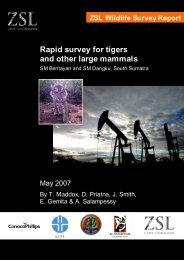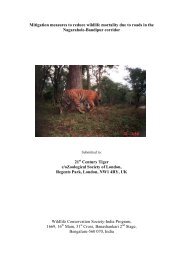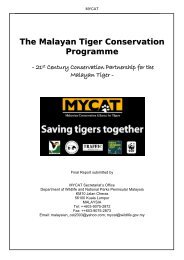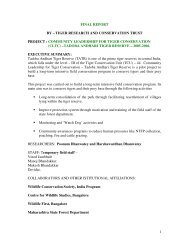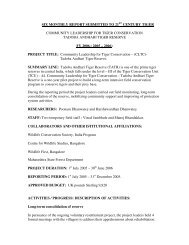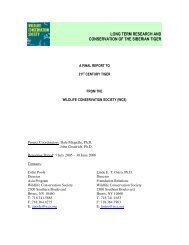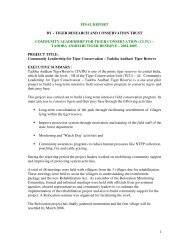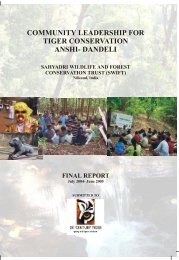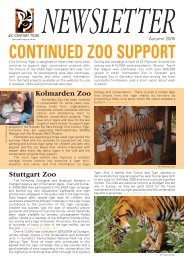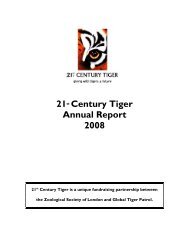The conservation of tigers and other wildlife in oil palm plantations
The conservation of tigers and other wildlife in oil palm plantations
The conservation of tigers and other wildlife in oil palm plantations
Create successful ePaper yourself
Turn your PDF publications into a flip-book with our unique Google optimized e-Paper software.
SUMMARY<br />
Traditional <strong>wildlife</strong> <strong>conservation</strong> <strong>of</strong>ten focuses on protected areas, management <strong>of</strong><br />
which forms the core <strong>of</strong> most countries’ <strong>conservation</strong> efforts. While such areas are<br />
absolutely essential for <strong>conservation</strong> success, limitations <strong>of</strong> size, location, isolation<br />
<strong>and</strong> management mean that for many species the protected area system is at best<br />
restrictive <strong>and</strong> at worst <strong>in</strong>sufficient. In many cases, l<strong>and</strong> outside protected areas also<br />
has <strong>conservation</strong> value. Whilst this is rarely <strong>of</strong> the quality found <strong>in</strong> protected areas,<br />
us<strong>in</strong>g the <strong>conservation</strong> potential <strong>of</strong> unprotected l<strong>and</strong>s can help overcome many <strong>of</strong> the<br />
shortfalls <strong>of</strong> the protected area system. For certa<strong>in</strong> species, especially those which<br />
naturally occur at very low population densities, this support could tip the balance<br />
from ext<strong>in</strong>ction to survival.<br />
Indonesia is one <strong>of</strong> the most biodiverse countries <strong>in</strong> the world <strong>and</strong> despite its<br />
extensive system <strong>of</strong> protected areas, many <strong>of</strong> its species are <strong>in</strong> decl<strong>in</strong>e. Commercial<br />
l<strong>and</strong>scapes dom<strong>in</strong>ate the unprotected areas <strong>in</strong> Indonesia, with the <strong>oil</strong> <strong>palm</strong> <strong>in</strong>dustry –<br />
particularly follow<strong>in</strong>g recent dem<strong>and</strong>s for bi<strong>of</strong>uel - the fastest grow<strong>in</strong>g sector <strong>and</strong> a<br />
major cause for concern amongst environmentalists. Whilst many argue aga<strong>in</strong>st its<br />
expansion, <strong>palm</strong> <strong>oil</strong>’s <strong>in</strong>creas<strong>in</strong>gly important role <strong>in</strong> both the Indonesian <strong>and</strong> world<br />
economies ensures that it will be a significant part <strong>of</strong> the l<strong>and</strong>scape for the foreseeable<br />
future. If the environmental impact <strong>of</strong> this crop is to be mitigated at any mean<strong>in</strong>gful<br />
level, the extent to which <strong>oil</strong> <strong>palm</strong> <strong>and</strong> biodiversity can coexist <strong>and</strong> the mechanisms<br />
by which this may occur must be assessed. In this report we <strong>in</strong>vestigate how <strong>oil</strong> <strong>palm</strong><br />
<strong>plantations</strong> may play a role <strong>in</strong> <strong>wildlife</strong> <strong>conservation</strong> <strong>in</strong> Sumatra, Indonesia. <strong>The</strong> study<br />
focuses on <strong>tigers</strong> <strong>and</strong> <strong>other</strong> large, terrestrial mammals liv<strong>in</strong>g on <strong>and</strong> around an <strong>oil</strong><br />
<strong>palm</strong> plantation concession <strong>in</strong> central Sumatra, an area that <strong>in</strong>cluded patches <strong>of</strong><br />
degraded forest <strong>and</strong> scrubby unplanted areas as well as the <strong>oil</strong> <strong>palm</strong> crop itself. <strong>The</strong><br />
analysis looks at species survival at the l<strong>and</strong>scape level (<strong>in</strong>clud<strong>in</strong>g forested habitats<br />
adjacent to the plantation), at the plantation concession level (<strong>in</strong>clud<strong>in</strong>g unplanted<br />
areas with<strong>in</strong> it), <strong>and</strong> f<strong>in</strong>ally species survival with<strong>in</strong> the <strong>oil</strong> <strong>palm</strong> crop itself.<br />
<strong>The</strong> results show that <strong>oil</strong> <strong>palm</strong> monoculture is very poor habitat for most terrestrial<br />
mammal species. Only four species (10% <strong>of</strong> the number detected with<strong>in</strong> the<br />
l<strong>and</strong>scape) were regularly detected <strong>in</strong> the <strong>oil</strong> <strong>palm</strong> itself <strong>and</strong> none <strong>of</strong> these species had<br />
a high <strong>conservation</strong> value. <strong>The</strong> degree <strong>of</strong> aversion to <strong>oil</strong> <strong>palm</strong> shown by the <strong>other</strong><br />
mammals varied. Most endangered species, <strong>in</strong>clud<strong>in</strong>g <strong>tigers</strong>, tapirs, clouded leopards<br />
<strong>and</strong> dhole, were never detected <strong>in</strong> <strong>oil</strong> <strong>palm</strong>. Some species, <strong>in</strong>clud<strong>in</strong>g deer, macaques<br />
<strong>and</strong> pangol<strong>in</strong>s showed limited tolerance but, with the exception <strong>of</strong> pigs, all species<br />
showed a general preference for non-<strong>oil</strong> <strong>palm</strong> habitats. However, many species<br />
cont<strong>in</strong>ue to survive <strong>in</strong> the vic<strong>in</strong>ity <strong>of</strong> the <strong>oil</strong> <strong>palm</strong>, utilis<strong>in</strong>g <strong>other</strong> habitat types also<br />
present <strong>in</strong> the matrix. Surveys <strong>of</strong> the overall l<strong>and</strong>scape around the crop revealed 38<br />
medium to large mammal species, 25 <strong>of</strong> which are protected under Indonesian law<br />
<strong>and</strong> 18 <strong>of</strong> which are on the IUCN red lists, <strong>in</strong>clud<strong>in</strong>g the Sumatran tiger (Panthera tigris<br />
sumatrae, IUCN: Critically Endangered). N<strong>in</strong>ety percent <strong>of</strong> these also occurred <strong>in</strong> the<br />
heavily degraded, unplanted areas with<strong>in</strong> the plantation concession itself. Many <strong>of</strong><br />
these species were previously thought to be highly <strong>in</strong>tolerant <strong>of</strong> disturbed habitats, yet<br />
most showed evidence that they were exist<strong>in</strong>g <strong>in</strong> function<strong>in</strong>g, persistent populations.<br />
F<strong>in</strong>ally the study highlighted the fragility <strong>of</strong> <strong>wildlife</strong> survival <strong>in</strong> such marg<strong>in</strong>al habitats.<br />
Over the course <strong>of</strong> the study, substantial loss <strong>of</strong> <strong>conservation</strong> value was witnessed as<br />
l<strong>and</strong> clearance <strong>and</strong> settlement <strong>of</strong> the <strong>wildlife</strong> habitats was illegally carried out by<br />
settlers. <strong>The</strong> plantation managers, though sympathetic to <strong>wildlife</strong> <strong>conservation</strong>, were<br />
unable to prevent this. <strong>The</strong> tiger population was particularly strongly affected,<br />
completely disappear<strong>in</strong>g from the plantation concession <strong>in</strong> the third year <strong>of</strong> the study.<br />
<strong>The</strong> study concludes that compatibility <strong>of</strong> <strong>oil</strong> <strong>palm</strong> crop with most mammal species is<br />
very low <strong>and</strong> that therefore conversion <strong>of</strong> l<strong>and</strong> to <strong>oil</strong> <strong>palm</strong> <strong>plantations</strong> will have major<br />
detrimental effects on most terrestrial mammal species, both through the <strong>in</strong>itial<br />
impact <strong>of</strong> habitat loss <strong>and</strong> through restrictions on rema<strong>in</strong><strong>in</strong>g local populations by<br />
habitat fragmentation. However, the study also highlights the <strong>conservation</strong><br />
Wildlife <strong>conservation</strong> <strong>in</strong> <strong>oil</strong> <strong>palm</strong> <strong>plantations</strong> 1




